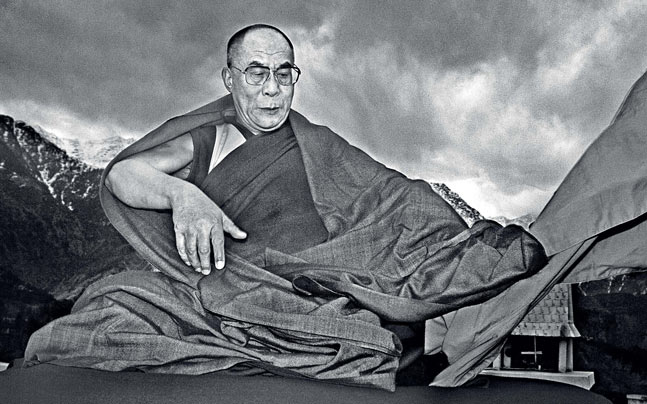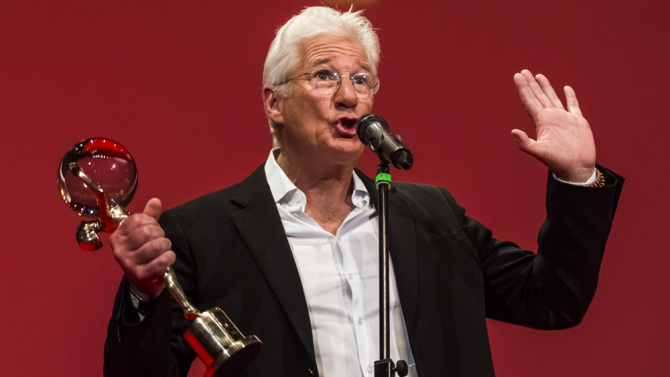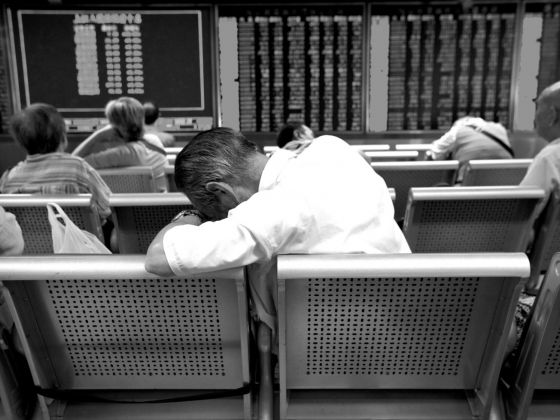The monk in the middle
Jyoti Malhotra, India Today | July 2, 2015
The Dalai Lama is making overtures to Beijing even as China seems to be hardening its stand
Sometime in the mid-1950s, Chinese President Xi Jinping’s father, Xi Zhongxun, met the young Dalai Lama of Tibet in Peking, and the two became friends. The Dalai Lama gifted the senior Xi a watch, which he was still wearing in 1980 when an envoy of the by-now middle-aged Dalai Lama, now resident of McLeodganj in Himachal Pradesh, met him in Beijing. In the intervening years, Xi Zhongxun had been purged by Mao’s revolutionaries and his son sent to live in a cave to look after pigs. But Xi Zhongxun survived and his son rose through the ranks of the all-powerful Communist Party of China.
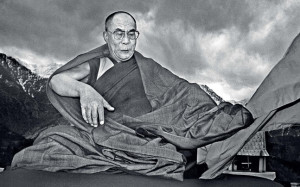
This week, en route to the US to celebrate his 80th birthday on July 6 with the powerful Tibetan community in California, the ageing Dalai Lama told india today in an exclusive interview that he would like to go home to Tibet-as well as meet his friend Xi Zhongxun’s son, President Xi Jinping.
Some would say that the Dalai Lama’s overtures to the Chinese government, through this frank interview, constitutes his most direct statement of interest to reopen talks with Beijing. Certainly, the Tibetan leader is pleading for an honourable settlement for his people, who have been coarsened and brutalised in the decades since the Chinese forcibly took over the province in 1950.
Others would argue that the Dalai Lama is indirectly admitting that he has few cards left. Or that he is laying them all on the table, in the full knowledge that China has become richer and much more powerful since he fled to India in 1959. The strategic set may contend that that is hardly a smart move; on the other hand a spiritual leader is hardly expected to anticipate the chess manoeuvres of a Communist leader who, in the last two years since he became president, has also assumed the six other most important positions in the Chinese military, party, economy and state.
If this were a direct contest between Tenzin Gyatso, Tibetan Buddhism’s holiest man, and Xi Jinping, the contest would surely be over before it started. But what is fascinating in this most unusual challenge is that the Dalai Lama has not only refused to treat the Chinese as his bitter adversary, he is in fact counting on the support of the growing numbers of “outwardly atheist but inwardly spiritual” Chinese Buddhists in civilian as well as military circles-400 million, according to him, and growing-to tilt the balance just enough so as to give him and the Tibetans a real chance.
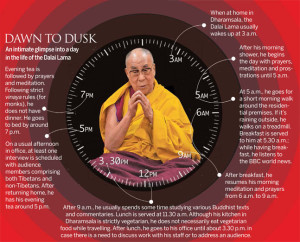 Meanwhile, the Chinese continue to reserve a special anger against this elderly monk in maroon robes. They have called him all kinds of names. They have put pressure on governments bullied civil societies and threatened NGOs with revocation of aid if they host him, or worse, allow him to propagate spectacularly absurd mush like peace and happiness and brotherhood. But the Dalai Lama, even in his 80th year, continues to be treated like a rock star, feted alike by influential people like Barack Obama, Richard Gere and Desmond Tutu.
Meanwhile, the Chinese continue to reserve a special anger against this elderly monk in maroon robes. They have called him all kinds of names. They have put pressure on governments bullied civil societies and threatened NGOs with revocation of aid if they host him, or worse, allow him to propagate spectacularly absurd mush like peace and happiness and brotherhood. But the Dalai Lama, even in his 80th year, continues to be treated like a rock star, feted alike by influential people like Barack Obama, Richard Gere and Desmond Tutu.
Truth is, just as the Dalai Lama has virtually single-handedly, transformed a broken movement-in-exile in 1959 to one recognised by the world today as having legitimate aspirations, he is also the only person in the world who can upset the Chinese where it hurts, in its soft underbelly.
“Despite the fact that he left Tibet so many decades ago, the Dalai Lama continues to have a large following inside Tibet. The Communist Party leadership simply cannot accept another organisation or leader beside itself which has such a genuine mass following,” says a former Indian ambassador to China who did not want to be identified.
MANN KI BAAT WITH THE MONK
Interestingly, the only major leader in the free world who seems to be as circumspect as the Chinese about the Dalai Lama is Prime Minister Narendra Modi. A meeting between the two on August 20, 2014, ahead of Xi Jinping’s September visit to Delhi is believed to have gone off badly. Indian sources told india today that the Dalai Lama was “virtually kidnapped,” put into an unmarked car with dark window shades as it drove into 7, Race Course Road, the PM’s official residence, that evening.
Asked about the meeting, the Dalai Lama laughed, but refused to say anything. As the sources put it, he was “visibly shaken” by the encounter. It seems Modi didn’t come out to receive him-unlike other PMs in the past. Moreover, he spoke to him in Hindi, which was translated into English. The Dalai Lama replied in English. They talked about a variety of things, including China.
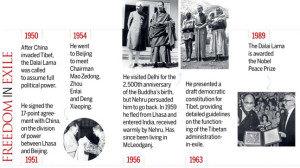 It seems the Dalai Lama, his advisers and a Hong Kong-based Chinese businessman friend had been discussing a possible meeting between the Dalai Lama and Xi during the latter’s Delhi visit. It is believed the government wasn’t too happy with these developments and had made its views known to the Dalai Lama’s people.
It seems the Dalai Lama, his advisers and a Hong Kong-based Chinese businessman friend had been discussing a possible meeting between the Dalai Lama and Xi during the latter’s Delhi visit. It is believed the government wasn’t too happy with these developments and had made its views known to the Dalai Lama’s people.
Certainly, many things have changed in the new New Delhi. For a start, the new PM recognises the need to reconcile the leftovers of history and make good with India’s largest neighbour. The PM also knows that a sustainable relationship with China cannot ignore the presence of the Dalai Lama and the Tibetan community-in-exile in India. Not because of the so-called “Tibet card” in India’s diplomatic arsenal-which has been so watered down by Delhi over the decades since the Dalai Lama arrived- but because the Chinese leadership sees the Tibetan spiritual leader as a veritable red rag to its predominantly Communist Party identity.
It is widely acknowledged that the Dalai Lama’s escape in 1959 only aggravated the already deteriorating relationship between India and China, leading to the 1962 border conflict and several consequent decades of tension. But as China rises again, nationalist feeling against the distinctive but dissenting cultures of Tibet and Xinjiang is only growing. “China’s main problem with the Dalai Lama is that it wants him to accept that Tibet has always been an integral part of China. No Dalai Lama can accept that, as this is historically debatable,” says Nalin Surie, a former envoy to China.
HINDI-CHINI BHAI BHAI 2.0
In his August 2014 meeting with the Dalai Lama, perhaps Modi believed that the beautiful new relationship he was about to forge with Xi would be unnecessarily damaged by an 80-year-old Tibetan leader the Chinese love to hate, who happens to be living in his country. Whatever the truth, Modi’s subsequent conversations with the Chinese leadership in Ahmedabad, Delhi, Xi’an and Beijing are said to have given him a proper insider’s perspective into the highly complex relationship with his big and powerful neighbour.
The Chinese are certainly keen on ramping up much-needed economic investment in India. But in recent years they have refused to consider a “status quoist, as-is-where-is solution” on the boundary dispute-that is, India and China keep the territories under their present control, Arunachal Pradesh and Aksai Chin respectively, as was twice contemplated in the past by Zhou Enlai and Deng Xiaoping-and insisted that any deal with India must incorporate Tawang, plus some additional territory from Arunachal Pradesh.
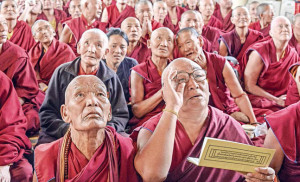
Certainly, only a strong government with a large majority can politically afford to cede territory to China. During the Atal Bihari Vajpayee era, talk of a “soft border” between Tawang and Tibet-similar to the proposal to transform the LoC in Jammu and Kashmir into a “soft border”-often surfaced, which soon died a natural death. Since 2003, 18 rounds of border talks between representatives of the two governments have taken place, but to no avail. In the interim, China’s economy has grown by leaps and bounds, transforming not only the eastern Chinese seaboard but also the hinterland within. With the train from Beijing to Lhasa beginning its first run in 2006, the Communist Party moved to populate Tibet’s towns with Han Chinese.
Then, in August 2013, the Indian Air Force landed the C-130J Hercules aircraft at Daulat Beg Oldi, the highest landing ground in the world, on the frontier with China in the Ladakh sector, near the theatre of the 1962 war. “The move sent shivers down China’s spine,” a retired Indian diplomat said. Other airstrips not used since the 1962 debacle were resurrected, at Chushul in the western sector and Tezpur in the eastern sector, where a squadron of Sukhoi fighter jets was placed.
“Question is,”asked a retired foreign secretary, “how do you play the game with the much more powerful Chinese, with a weak hand? The answer is to put in place a strike capability the Chinese are also aware of.”
Former foreign secretary Shyam Saran, also a Mandarin speaker, believes the Dalai Lama has “brought back to India a unique spiritual heritage which had dissipated in the intervening centuries. We cannot calculate the Dalai Lama’s value or importance in political gains or losses. After so many years here, I can proudly say that he is now also owned by India”.
It seems Modi and BJP President Amit Shah, who cancelled a last-minute meeting with the Dalai Lama on the eve of Modi’s visit to China in May, have since rethought their hardline views. For the Tibetan leader’s June 21 celebrations in McLeodganj, Modi sent Union Minister for Culture Mahesh Sharma and Union Minister of State for Home Affairs Kiren Rijiju. “The government would like to reassure His Holiness that it holds him in the highest esteem”, Sharma said.
Towards the end of his interview with india today, the Tibetan leader indicated that he could, indeed, be the last of the Dalai Lamas, the very end or “ceasing” of the line. So much better, he said, to end the 600-year old institution with him (“who is quite popular”) than continue “to the 15th Dalai Lama who may turn out to be a disgrace”.
The Dalai Lama laughed his childlike laugh following his own remarks, but he seemed dead serious. Perhaps he was making these remarks with an eye to Beijing, so as to deny them the opportunity to subvert another sacred institution.
In this game of shadow-boxing with China, perhaps the Dalai Lama stands no chance at all. But the fact remains that he is still around at 80, smiling and laughing and exhorting his audience to focus on the messages of the Nalanda philosophers such as Nagarjuna. Perhaps that is the real value of him spending all these years in India, and elsewhere in the free world.

